
The why and how of integrating employability in higher education
Date: 07/01/2020 | Posted by: MeritTrac | Category: Employability , Education
"Employability refers to a person's capability of gaining initial employment, maintaining employment, and obtaining new employment if required"
- Jim Hillage and Emma Pollard
Education consultant Bob Goddard in 2012 predicted the students' population in universities will double to 262 million by 2025 – with about half the growth contributed by India & China. According to the UNESCO policy paper in 2017, the students in higher education between 2000 and 2014 rose from 100 to 207 million. Along with that, the same period witnessed a jump in gross enrolment ratio (GER) from 19 per cent to 36 per cent.
This growth in enrolment and graduation is visible in India itself. The total enrolment in higher education increased to 37.4 million in 2018-19 from 20 million in 2012-13. The national GER also got improved to 26.3 per cent from 25.8 per cent in the previous year. As per the data from the Higher Education Survey 2018-19, over 8 million students completed their education in 2018.
These statistics pose many questions in our mind including the employment of pass out students and their quality. As we know the skills and competencies are the basis for employability. Are our students acquiring job-ready skills from their education so they can compete in the labour market? This question leads us to explore the importance of employability in education.
Many scholars have given various definitions to employability since the parameters change from time to time, region to region basisthe prevailing situations. Though definitions are varying, the common factor is integrating employability in higher education. Let's examine it's importance and possibilities.
American Society for Training and Development (ASTD) proposed 6 skill groups as the core area for employment.
Table 1: 6 skill groups proposed by ASTD
|
No |
Group |
Skills |
|
1 |
Basic Competency Skills |
Reading, Writing, Computation |
|
2 |
Communication Skills |
Speaking, Listening |
|
3 |
Adaptability Skills
|
Problem Solving, Thinking Creatively |
|
4 |
Developmental Skills
|
Self-Esteem, Motivation and Goal-Setting, Career Planning |
|
5 |
Group Effectiveness Skills |
Interpersonal Skills, Teamwork, Negotiation |
|
6 |
Influencing Skills |
Understanding Organizational Culture, Sharing Leadership |
National Association of College and Employers (NACE), a professional association that connects college career services to potential employers had compiled a list of the top 20 skills requested by employers in 2007. This list has ranked the top 20 employer-required, which include almost all the cognitive and non-cognitive skills.
Table 2: Top 20 employer-required skills prepared by NACE
|
Rank |
Skills |
Rank |
Skills |
|
1
|
Analytical Skills |
11 |
Leadership and Management Skills |
|
2 |
Communication Skills |
12 |
Motivation/Initiative |
|
3 |
Computer Skills |
13 |
Organizational and Time Management Skills |
|
4 |
Creativity |
14 |
Real Life Experiences |
|
5 |
Detail-Oriented |
15 |
Self-confidence |
|
6 |
Risk-Taker |
16 |
Strong Work Ethic |
|
7 |
Flexibility/Adaptability |
17 |
Tactfulness |
|
8 |
Friendly |
18 |
Teamwork Skills |
|
9 |
Honesty/Integrity |
19 |
Technical Skills |
|
10 |
Interpersonal Skills |
20 |
Well-mannered/Polite |
However, 58 per cent of employers worldwide believe that graduates are not adequately prepared for work.
Therefore, many plans and programmes were proposed to fill this gap. The Commonwealth of Learning (COL), an intergovernmental organisation working for the improvement of education and learning in the commonwealth countries, has proposed a four-phase model to integrate the employability in higher education. This model helps universities to implement a comprehensive system to improve the employability of the students.
Employability for nation-building
The employable graduates are the backbone of the economy. Therefore, improving the employability of students in higher education should be the utmost priority for any country to achieve growth and development.
The governments should frame the policies and guidelines for enhancing the employability by integrating it with the education system. This can be done by leveraging employers like PSUs, corporates, or others with higher education. Thus, educational institutions can develop own policies and curriculum to prepare the students according to the job market requirements.
Governments should assist both educational institutions and employers to come together to build a holistic employability plan.
Upping the ranks of educational institutions
Increased number of students getting placed through a campus recruitment drive or other ways is an added benefit for the educational institutions. It will increase their enrolment as well as the ranking of the institutions. Having a plan to improve employability would help achieve this objective.
The COL model talks about the step-wise plan to integrate the employability in university education. Institutional-level assessment and setting up a task force is the first step, according to the COL model. The task force will implement the plans accordingly. This would be a cyclical and continuous process.
Syllabus and Curriculum can be designed or redesigned based on government guidelines following a comprehensive assessment and consultation with the industry and employers.
A better future for students
Whatever the definition we utter as the outcome of education, the ultimate individual goal is getting employment. A student enrolling at a higher education institution aims to gain a good job soon after s/he finishes the course. Many students take bank loans to pursue the education expecting a decent post-course return. But if the institution cannot nurture them with market-demand skills, the students struggle to get into the jobs and grow. This is the reason for underemployment and unemployment.
Integrating employability in education is helpful for the students to acquire the job-ready skills beforehand and excel in the new workplace from day one. For this, they have to force the institutions to add skills to enhancing employability. The students should take such skill development programs seriously and take part in various assessment and testing as part of the programmes to know their strength and weakness. Thus, they can enhance themselves in order to get a good offer as well as maintaining that employment or go for a better job in the future.
Natural flow of talents directly from campus
Employers have to spend a lot on sourcing, selection, assessing, hiring and training the new talents in order to fully induct in the organisation. This cost can be reduced if the employers - corporate or government - is involved in employability programmes in higher education institutions.
The corporates can give consistent inputs for developing the resources and implementing the plans to enhance the employability. The organisations can collaborate with the institutions which teach the course related to the domain/area the organisations belong. This will help employers to source and hire the right talent effortlessly.
These are some of the outcomes from integrating the employability in higher education. This can be accomplished only with a synergetic effort of all the stakeholders and consistent skill assessment and training.
This can be illustrated as follows:
Handpicked Articles for Futher Reading
Relevant Case Studies/Whitepapers:














 Sales Hotline: USA: +1 646 916 0939 / Others: +91 80619 14700
Sales Hotline: USA: +1 646 916 0939 / Others: +91 80619 14700


